
This article appears in West 86th Vol. 28 No. 1 / Spring–Summer 2021
To be lost and found at sea: What kinds of thinking does the shipwreck prompt? This essay pursues this question by centering fragmented remains—large beeswax blocks and Chinese porcelain ware—from the Santo Cristo de Burgos, a Spanish galleon lost while traveling from Manila to Acapulco at the end of the seventeenth century. By considering how durable commodities were recovered and reimagined, primarily by Indigenous inhabitants of the Oregon coast, this essay reflects upon the kinds of histories that can be written around and because of wrecked ships. Tacking between past and present, we use the Santo Cristo de Burgos to draw out the lineaments of a shipwreck’s art history, bringing into focus three interrelated themes, each critical to the material histories of wrecks: the interpretive recalcitrance of cargo, the reframing of value through recovery, and the production of material surplus in the watery depths.
In 1720, while living in Lima, one Arnaldus Alexander Durand Baro de Mazabrat presented a petition to the viceroy of Peru. His hope was to curry favor through an ocean-bound invention (fig. 1).1 A drawing produced to show off his new apparatus depicts a man enclosed within a leather shell reinforced with iron bars. Vest, sleeves, and britches protect what seems to be a muscled physique. A bulbous hood and a plug seal the suit, the latter protruding from where we should imagine a human mouth. The manuscript page carefully describes this outfit and its function, using an alphabetic key to identify each piece of the diving suit. It tells us, among other things, that the curlicue-ing tubes and futuristic switches ensure a man can breathe even as the weighted device sinks him into the sea, up to a depth of twelve brazas (or roughly twenty meters). Breathing underwater, of course, would not be enough. Protuberances on the helmet, labeled “F,” represent glass lenses. A diver could use these things, after all, to see as he went about his work: the seemingly miraculous recuperation of shipwrecked treasures.
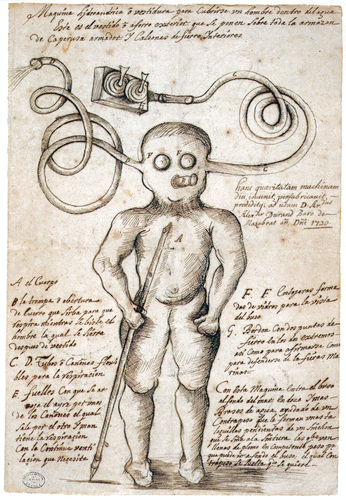
Putting one’s trust in such an apparatus, at least as described, would have been a tricky proposition. And today, that is surely part of its charm. For the diving suit invites us to consider a range of tantalizing possibilities: Could it really work; for how long could one stay submerged; and even more thrillingly, if it did work, what might one find braving the sea encased in this outfit? Proffered as a kind of sales pitch, the drawing trades in fantasies of recovery. It indexes the illusion that any errant ship (and the luxuries that it portered) could be found, that goods gone “missing” could be recuperated. In the Iberian world in the eighteenth century, dreams of riches drawn back from the ocean were clearly alive and well.
The eighteenth century had no monopoly on such desires. As Paul Virilio has noted, “To invent the sailing vessel is to invent the shipwreck.” 2 And indeed, wreckage has gone hand in hand with empire since antiquity. Transit and its perils were fundamental conditions, integral to the extractive economies that propelled ever-greater hunts for raw materials, specimens of natural history, gems and precious metals, territory to claim, and no less important, bodies to remake. In the early modern world, long-distance shipping knitted ports and funneled commodities, not a small number of which were people enslaved and shunted across oceans. Shipping news was awaited on many a shore, and when cargoes failed to arrive—because of storm, war, pirates, sickness, or careless commandeering—there was much to mourn. Loved ones were lost, investments failed, and documents, from personal letters to governmental missives, disappeared. These are just some of the reasons that Baro de Mazabrat’s diving suit held so much promise, even if the endeavors it was designed to support would likely be hard won. 3
Salvage, extraction, recovery: these projects are no less seductive today. An entire industry of underwater archaeology has emerged to scrape ocean floors and seabeds for what can be found and surfaced. 4 Porcelain vessels (fig.2), excavated from the wreck of the San Diego off the coast of the Philippines and now on display at the Museo Naval in Madrid, embody some of the promise of shipwreck archaeology. Among art historians and collectors, in particular, these jars are visually enticing and historically noteworthy for their script, iconography, and facture—and that ante is upped by the wondrousness of their having survived underwater for hundreds of years. 5 Yet not all shipwrecks offer objects that translate so conveniently from archaeological find to work of art. Nor are all so transformable into historical evidence of, or recovered treasure from, the colonial past.
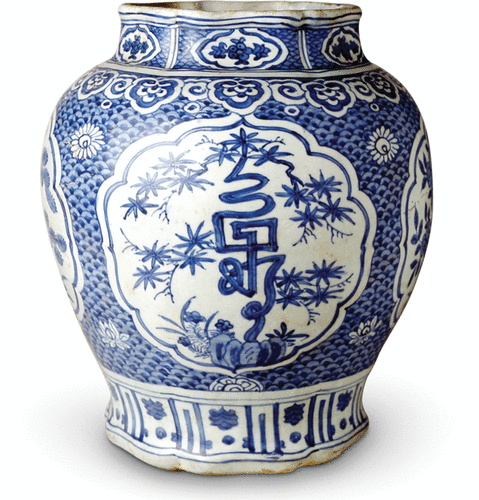
Take, for instance, a few small fragments of porcelain that washed up on the Pacific coast of Oregon (fig. 3). At first glance, they are not much to look at. The baggie that holds them in the museum seems almost materially more present than the ceramics themselves. And yet every month, twenty to thirty similar Chinese porcelain fragments—remnants of a trans-Pacific crossing gone awry—wash ashore on the northwest coast of the United States. 6Sometimes these chips get put into pockets, but sometimes they are donated to local museums. Beachcombers are often the ones to find these sherds while traversing the sands and rocky coastlines between Cannon Beach and the mouth of the Columbia River (as the handwritten label from the Astoria Maritime Museum suggests). Arriving ashore bit by bit, they signal, almost melancholically: not all goods sent from Asia to the Americas made their arrival as planned. 7
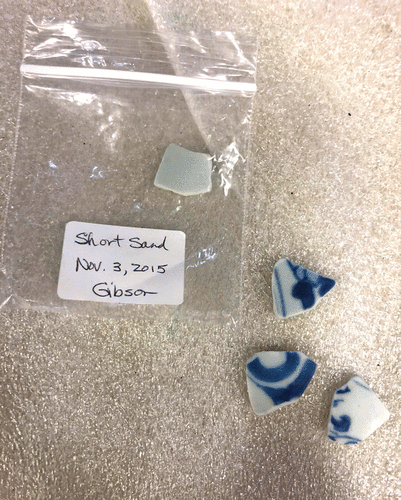
These patterned fragments are large enough to date and came from hands at work in seventeenth-century China. As whole objects, the porcelain likely once traveled on the Santo Cristo de Burgos. 8This ship left Manila in 1693 but was one of a few Spanish galleons that did not successfully reach Acapulco, the intended port of arrival. Rather, the Santo Cristo de Burgos may well have ended its journey far north, off the coast of Oregon, where Indigenous communities lived. 9Whether the ship actually wrecked or foundered near shore remains unclear. Either way, recent geoarchaeological work has revealed that the remains of the galleon then underwent quite dramatic events.10 Stratigraphic data show that around 1700 an earthquake shook the region and dropped the coastline. In rushed a tsunami. This confluence of environmental shifters scooped up pieces of the ship and its cargo, scattering them along the Nehalem spit and further inland into the adjacent valley. 11 If funding were no object, the afterlife of the Santo Cristo de Burgos would still foreclose any possibility of intact recovery. Instead, the remains of a colonial-era cargo gone astray are slowly being disgorged by the ocean.
This scene on the Oregon coast is seemingly inhospitable to art historical looking. Or is it? In this essay, we take the interrupted trans-Pacific crossing of the Santo Cristo de Burgos as more than a historical curiosity, seeing in it opportunities—specifically, to contend with shipwrecks art historically. There is, of course, a full literature on shipwrecks and their debris. Maritime historians and archaeologists have taken the lead in this kind of research. Even as art history has become more interested in questions of mobility and transit, the discipline’s embrace of the oceanic turn has nevertheless been rather circumscribed, especially when compared with others in the humanities (a point to which we return below).
It may be counterintuitive, but this essay does not feature iconographies or representations of catastrophes that unfolded at sea, though there is much to say about these things. Nor will we recount tales of marooned sailors or enslaved people, pirate raids, battles, or warships; we also set aside early modern plays and poetry, along with prehistories of the heroic sublime.12 Against the backdrop of such scholarship, we instead argue that shipwrecks can expose art historical expectations and desires around both aesthetics and evidence. Since outliers and exceptions tend to call attention to norms, we use the Santo Cristo de Burgos to summon the methodological and theoretical possibilities of looking at wreckage, drawing out the lineaments of a shipwreck’s art history. To do so, we bring into focus three interrelated themes, each critical to the material histories of wrecks: the interpretive recalcitrance of cargo, the reframing of value through recovery, and the production of material surplus in the watery depths. Our broader project, then, is an experiment in thinking through salt water and not merely about the mobilities occasioned by it.
Isn’t This Lovely?
If all had gone according to plan, the Santo Cristo de Burgos would have left the Philippines and sailed for roughly six months across the Pacific Ocean. In Acapulco, chests, trunks, and bundles would have been unloaded and dispersed to eager merchants, middlemen who would distribute and transfer precious objects and other commodities throughout New Spain.13 Some of these goods would have been portered across land to Vera Cruz to be loaded onto yet other ships and forwarded on, to consumers and collectors in Europe. Why none of this happened remains unknown. Ethnohistoric accounts tell of foreigners taken in by Indigenous communities, suggesting that the boat foundered but that some who sailed upon it, along with some of their goods, made it to land.14 Since the ship has never been found, its presence has instead been signaled by remains that have consistently been washing ashore.
The Santo Cristo de Burgos has long been known by a more popular name: the Beeswax Wreck.15 In terms of sheer scale—size, weight, volume—wax would have been among the galleon’s most important cargoes. While more than a little of this wax has surfaced, there has been no big reveal. The wax known today has come to us, like the porcelain chips, slowly and unpredictably.16 Because of its material qualities, wax once packed onto the Santo Cristo de Burgos survived both earthquake and tsunami, but not without consequences. Plentiful quantities seem to have been pulled up to shore with the turbulent, surging water; as sandy and muddy flows edged back into the sea, they buried wax blocks that had been dislodged from the ship. From time to time, in the intervening centuries, large pieces of the wax have surfaced, becoming visible as rains eroded patches of earth and sands shifted with wind and current. Writing in the early twentieth century, S. J. Cotton tells of remnants being found in extraordinary locations: “[S]ome of it [wax] has been discovered more than a mile [inland] from the nearest beach.” Cotton registers the serendipity of such finds in describing farmers “unearthing a monstrous stump” and pulling up “a chunk of wax” entangled amid its roots. 17
Wax was hardly an unusual cargo in the Manila galleon trade. Tons (and tons) were collected as tribute from Indigenous people in the Philippines before making the transit from east to west, where the wax could be sold for a profit in the Spanish Americas. Melted and then cast or dipped to form candles, wax was necessary for Catholic rituals and integral to the spiritual economy. American bees of the stingless genus Melipona produced little wax, which by the standards of settler colonists was considered sticky and difficult to purify,18 so the Spanish Americas imported beeswax primarily from Europe and Asia.19 European wax, which came from the Apis mellifera, was thought to be the purest, to burn the cleanest;20 Asian wax was considered perfectly usable and definitely good enough for ritual use. Besides, there was plenty to be extracted from island bees (Apis cerana). In all of this, the substance reiterated the geographic hierarchies of empire.
From the wreck of the Santo Cristo de Burgos, we catch wax uncannily in medias res (fig. 4). Given the expected “career arc” of this material, seventeenth-century trans-Pacific wax is not something one often gets to see, let alone hold. Shipper’s marks, normally gleaned only from archival documents, are here found incised into partially processed material. Carved after the melted wax had sufficiently hardened into blocks but remained malleable, these channeled marks index a blunt-pointed tool. These symbols were meant to direct particular blocks into the proper hands at port, people who would have been responsible for moving the wax along the supply chain and collecting the profit. But because the journey was aborted—and therefore the material was not burned down to stubs and recycled—it is now possible to appreciate the way that the blocks would have responded to the very hands that came to move them. Even today, and even when gloved per museological practice, the warmth of a hand unleashes aroma: the heady scent of beeswax over three hundred years after harvesting and shaping. This is more than a little startling, for one does not expect to smell history,21 nor does one expect colonialism’s effluvia to carry the sweet fragrance of honey.
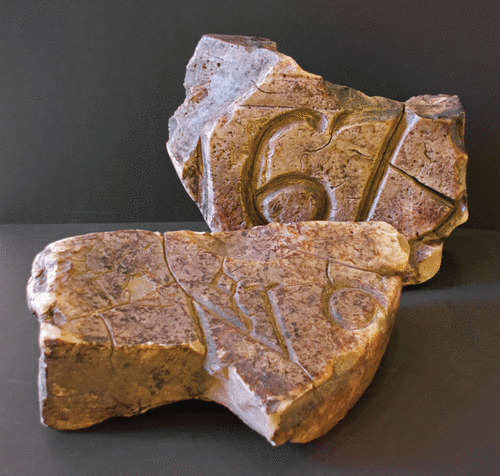
Scent and symbol, to say nothing of sheer material heft, remind us that these wax blocks were bulk commodities. Some now-fragmented but surviving pieces weigh more than forty pounds. Albeit darkened by dust, sand, and time, these blocks offer tangible traces of the mechanics and sensorial plays of early modern trade. In certain cases, however, it would not be hard to mistake some larger hunks for rocks (fig. 5). Melted and reformed, composite pieces cracking at the seams, infiltrated with earth and debris: this large wax boulder uncannily blurs, almost perfectly, the boundaries between artificialia and naturalia. Such an object—is it even an object?—is rather odd, but exciting to encounter.
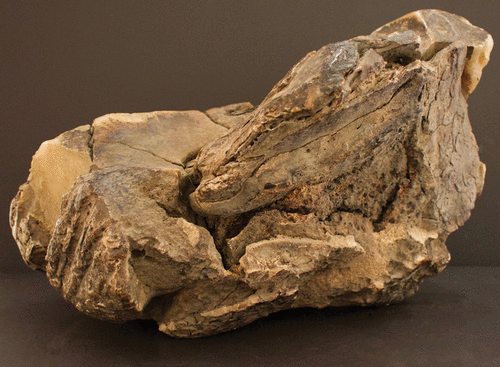
For all of this frisson, the wax of the Santo Cristo de Burgos hardly dazzles the eye. Curiosities these hunks may be, but they are certainly not the kind of treasure most people expect when they hear the phrase “sunken galleon” or “shipwreck bonanza.” An emerald cross, though, is another story (fig. 6). Dredged from the sea off the coast of what is today Florida, this shimmering pendant counted as a precious piece of cargo on board the Nuestra Señora de Atocha, another ill-fated Spanish galleon—this one heading from the Americas to Europe earlier in the seventeenth century.22
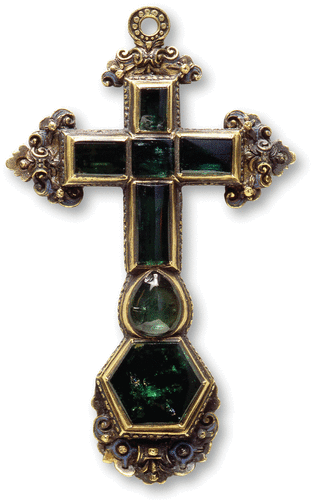
Composed of seven large emeralds, the cross calls up the familiar flows of colonial economies: gold from mines in the Andes and emeralds also extracted from deep within South American soil.23 The design itself was also a product of trade, the strapwork curls having been introduced to American workshops via European prints shipped out from ports like Seville. 24 The techniques of repoussé and punchwork used here also aligned its production with European practices. In very fundamental ways, this cross exists because of the mobilities now recognized as intrinsic to early modern, especially trans-Atlantic, art making and consumption. It could be read as a quintessential object of global history fortuitously pulled up from a drowned ship.
One normative interpretive gesture would be to reconstitute this history, extending the lines that we have begun to sketch, for mobility, circulation, and trade have become key terms as art history writing has gone global. A further move might also highlight the elite intentions that animated the cross’s journey to begin with, the social life imagined for this cross and almost, but not quite, fulfilled. Documents could facilitate these modes of analysis, but even more evocative would be an exquisitely painted portrait (fig. 7). The Atocha cross finds its kin in the one worn on a chain around the neck of Isabella Clara Eugenia—daughter of Philip II, archduchess and then vice-regent of the Southern Netherlands—as she was pictured by Frans Pourbus the Younger just before the turn of the sixteenth century (shortly before the cross carried by the Atocha found its way to the ocean floor). The emeralds that she wears have been cut to slightly different shapes, and pearls dangle from drop loops on the cross’s arms, but the painting offers quite a vision of glinting gold and sparkling emeralds offset by the backdrop of brocades and silks.25 It is not hard to imagine the Atocha cross being worn in just such a way.
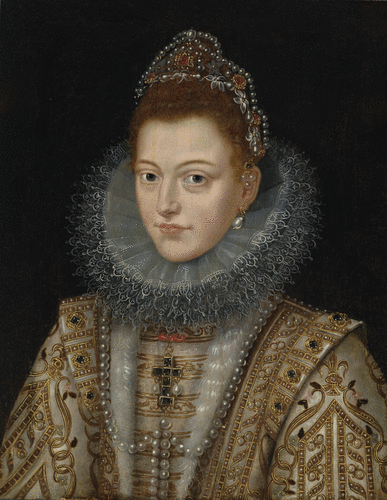
Setting cross beside portrait opens the door to recursive art historical validation. In a discipline often dependent upon positivist argumentation, the cross and portrait seemingly evidence one another. Working from cross to painting, we see that the painter was not merely taking artistic license to delight his patron’s eyes or those of the portrait’s viewers; nor is the painted ornament strictly an emblem of prestige, bestowed upon a royal figure. If we track, instead, from painting to cross, we are reminded that while art does not always depict daily life, sometimes it comes close enough.26
In conjuring up all the rather lovely things that might still be underwater, that still could be pulled into the present from cargoes seized—and still held—by the sea, this pairing returns us to the shipwreck. Of course, this emerald cross was not brought up from the ocean floor looking as dazzling as it does reproduced here. It had to be cleaned and buffed before being photographed and displayed. 27 Turned into a sparkling luxury, it becomes a treasure hunter’s (along with an art historian’s) prize. Once the emeralds and gold have been transformed into a find, the cross from the Atocha together with Isabella’s portrait issue a kind of directive: go forth and search. If luck is with you, other jewels might still be found. Few art historians and curators regularly don wetsuits, but plenty of treasure comes their way from those who do; and having the opportunity to turn underwater salvage into art via interpretation and display is good work when one can get it.
It is harder, by far, to know how to treat more prosaic shipwrecked objects. Unlike the Atocha cross, there is no “restoration” of wax from the Santo Cristo de Burgos, no return to an “original condition” that one could reasonably undertake today. One might melt the beeswax to clean or purify it, but such gestures of reformation are not really the work of honorable historians. Moreover, the current physical forms of the blocks—which, at best, resemble architectural fragments—are tough to read as pieces of sculpture. Signs of “artisanal” making were rudimentary to begin with, and the material was common and workaday. Of course, there were plenty of commodities in the Iberian world deemed worthy of a gold mounting and a place in the Kunstkammer. Bezoar stones and coconut shells come most readily to mind. To the best of our knowledge, wax chunks were never treated so indulgently. So what we find in Oregon are fragments that seemingly refuse the possibility of artfulness (certainly now, if not also then). This raises the specter of an art historical quandary: namely, What commodities is the discipline willing to consider and treat in terms of period visuality and sensorial appeal?28 Shells, silks, chintz, paper—certainly. Wax … perhaps not so much.29
Some would argue that the foundational theorists of art history (Wölfflin, Riegl, et al.) were right in thinking that true “art objects” enjoy a distinctive position in cultural history, allowing one to read deeper and more complex cultural meanings than one could from mere stuff. We understand those impulses, and the position that certain objects that surface from the sea are (or should be) simply beyond the art historical pale.30 For us, such modes of thinking call attention to latent expectations of what a “good” shipwreck will look like.
If we recalibrate the value of visuality (and with it the value of material splendor), wax could become a worthy art historical challenge rather than merely a noncompliant oddity. In our particular case, one could begin by attending to scale and weight. It is no coincidence that, at their widest points, many wax blocks of the Santo Cristo de Burgos are roughly shoulder width and (extrapolating from their current heft) weighty enough to make a trip carrying (or carting) them worth the effort, but not too heavy to hamper transit. That is, they seem to have been contrived for the human frame—specifically to bodies that would porter them.31 Size and shape also made it possible to safely deliver the blocks to their recipients, those who expected money in return (and whose names corresponded to the particular marks, numbers, or symbols, carved into the mass). Some might wave all this away as labor history. However, creation and production—particularly when geared to human actors—feel to us like baseline art historical concerns.
Almost in spite of themselves, then, the wax blocks push us toward a phenomenological reading of objects.32 Their weight and tactile qualities—craggy in spots, smooth like a polished stone in others—are just the beginning. The powerful, unexpected scent of the wax blocks fills the vitrines in which they are now stored, and in so doing opens a window to reimagine the honeyed (rather than just salt-tack and spit) aroma of the ship. With all this in mind, we might return to the emerald cross of the Atocha. Apart from the cross’s optical qualities—the refracted glow of its gems, the design of its strapwork—there is its heft. To be sure, there is (and was) monetary value at stake in measuring its emeralds and gold; but perhaps the more important point is to gauge the drag it once produced on the chain around the neck and the affect of pleasure (or obligation) that came with owning and caring for such a thing. The wax’s scent also calls up the aborted ritual work it was intended to do, for had the beeswax made its way to port and been turned into candles to be set alight in a church in Mexico City or Puebla, it would have perfumed the prayers of the faithful. For those Catholics who knew its end game, the smell of the wax hearkened the scent of salvation.
Of course, the cross around the neck was a perfectly useful Catholic symbol, and one that no doubt would have played a role in a private spiritual life. While one tends not to smell emeralds, one might well polish gold or feel the chill of metal against the warmth of one’s body. Moreover, flipping the cross (fig. 8) reveals delicately engraved depictions of Virgin and Child, together with Saint Anthony of Padua, standing with the palm frond of martyrdom in one hand and the Christ Child, again, in the other. These emblems of Catholic devotion were in certain ways as precious as the emeralds, for they could sit close to the heart of the cross’s wearer. We may not know the iconographies (if they existed at all) that backed the emeralds in Isabella’s cross, but we should take seriously how affective presence could be amplified through bodily contact.
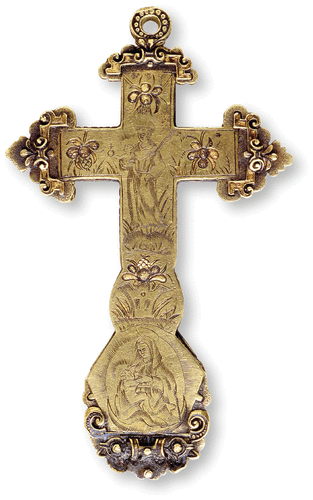
One does not necessarily need a shipwreck to read objects this way. But centering the scene of the wreck puts the loss (if not the recovery) of the wax and the cross into a different relationship. The wax more than overwhelms the jewel. In the face of its tonnage and the work that wax was expected to do—a literal matter of salvation in Catholic ritual—it becomes harder to take the cross so seriously, to read its loss as more than the displacement of another rich woman’s bauble. This shift in frame of reference presses up against the presumed (im)permeability of the boundaries between art and commodity, and the mechanisms by which an object or substance shifts from one category to the other.33
When it comes to art history, then, what are current practitioners of the discipline really willing to look at? Why, apart from the conditions set by the market, does the discipline allow some commodities, but not others, to challenge familiar aesthetic categories and modes of reading? The shipwreck can turn “mere” mass-produced objects into treasured sculptures of the sea, and buried treasure into little more than a fused lump of mineral. Such things, when they are valued at all, tend to lead toward the exotic and the extraordinary; otherwise, they are supposedly dismissible as detritus. That is, shipwrecks proffer more than their fair share of intractable objects and visualities. But the production of recalcitrance, we assert, offers an important entrance to interpretation in its own right. Indeed, we lose more than meets the eye when we indulge the fantasy that art history need not query its own recalcitrance—when, in other words, we privilege the pleasures of rescue over the work of wreck.
Value Added
For those of us anchored in art history, we have been arguing, the shipwreck requires looking beyond the most obvious sets of values that coalesce around recovered goods of trade. Indeed, if we think about the shipwreck and its aftermath as a site of value production, it is still necessary to ask what sort of value shipwrecks generate and for whom. Here is where the history of the Santo Cristo de Burgos, as exception rather than norm, offers traction. Because the ship and its cargo have been wrecking, one might say, for over three hundred years, their fate allows us a long view—especially onto the ways that goods released by the sea become subject to revaluation.
In the Iberian world, when ships sank near shore, rescue efforts could be both expensive and extensive. Retrieving precious metals and the formal registry of cargo (a paper record coveted for its information) were high priorities, but the salvage of artillery and other goods could be considered worth the labor of hundreds of people and months, if not years, of work. Divers, officials sent from afar to oversee logistics and account for the king’s silver, people familiar with local topography, and those who could be paid to feed the foreigners—all had roles to play in extracting goods from the sea.34 Once efforts moved from water to land, the principle and practice was to sort property so that it could be returned to its legal owners, whether private individuals or the Crown. Theft during rescue projects was common, as was the discovery of contraband: merchandise was supposed to be assayed at port before transit, although more than a few commodities never made their way into any logbook. Fines might be levied and offenders punished, but shipwrecked goods were highly mobile and remarkably fickle. The legalities and claims of people sitting onshore—in offices, customs houses, or tents set up to temporarily store salvaged goods—only snared and tamed some goods making their way around the world.35
None of this came to pass for the Santo Cristo de Burgos. The scattered information that exists suggests, instead, that from the late eighteenth century onward, local residents of the Oregon coast—primarily people today known as members of Nehalem-Tillamook and Clatsop communities—claimed cargo as it was offered up piecemeal by the sea. Wax and porcelain, however, were not materials for which they shared the same tastes as consumers farther to the south in Acapulco or Mexico City, or farther to the east for that matter, in Amsterdam or Madrid. There are no doubt many reasons for this. But one has to do with the particular historical status of Oregon’s coast and its Indigenous people at the turn of the eighteenth century. The Santo Cristo de Burgos foundered near shores that had not been brought into Catholic imperium, not yet been colonized. Rather, the people who slowly recovered cargo still lived on territory that was, technically, too far north for the Spanish Crown and its missionaries, too far south for the Russians. So as Asian commodities were churned from the galleon’s hull, they slipped into Indigenous hands and out of colonial circulation.
As this happened, commodities became detached from both the expectations and the frames of value that had animated their movement west from Manila. We see this perhaps most evocatively with the porcelain plates, jars, and cups, which potters in Jingdezhen, China, had been turning out by the thousands. From the late sixteenth century on, Jingdezhen’s kilns stirred a truly global taste for blue-and-white ware. This is a story now often rehearsed—one of export values, an international race for porcelain technology, and a near-frenzied consumption of goods produced for every register of foreign economies. Art historians perhaps know best the grand porcelain displays of Charlottenburg and Versailles and Topkapi, but products from Jingdezhen moved more freely across registers, both geographic and socioeconomic. For instance, settler colonists in New Mexico and Alabama possessed porcelain, and caciques from western Mexico commissioned armorial ware. And excavations in what is now the US state of Georgia reveal that enslaved people handled (if not owned) porcelain imports from China.36
So ubiquitous was the taste for porcelain, and so uniform the features desired and appreciated, that it would not have been surprising if Nehalem-Tillamook and Clatsop collectors had fallen in line. If they did, there is little evidence. Instead what has survived of Indigenous habits of consumption are meticulously reworked pieces of blue-and-white ware once carried upon the Santo Cristo de Burgos (fig. 9). Enough glazed surface remains to locate the porcelain’s originary moments in Chinese factories.37 If the glossy glaze or the smooth, white interior of Jingdezhen wares elicited pleasure in Indigenous eyes, these were not the only features of porcelain most valued. Density certainly seems to have mattered, and so too did hardness.
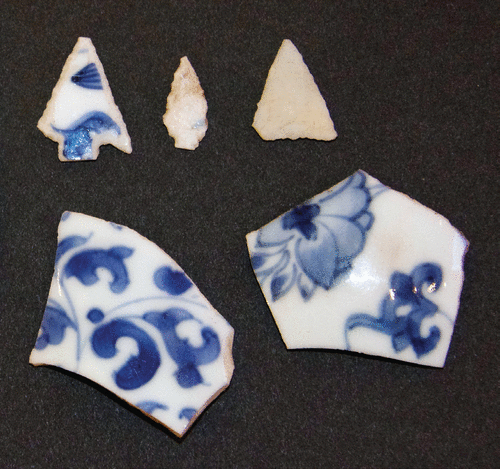
These qualities were appreciated widely in the eighteenth century. They may also have registered aesthetically for Clatsop and Nehalem-Tillamook residents of the Oregon coast, but it is hard to say. What is clearer is that the density and hardness of porcelain were put to use. Worked carefully, fragments of imported jars and cups yielded a wicked, jagged edge. More nibbled than knapped, the arrowheads manifest blue-and-white ware becoming lethal. Looking at these tiny weapons brings to mind the history of porcelain production and all the ways that craftsmen in China modeled their objects on foreign forms: gin bottles and tulip containers, ewers and lidded boxes. Yet here the process was reversed. Indigenous makers pulled form—in a subtractive process—from porcelain objects whose original shapes were likely fractured before arriving on the Oregon beach.
By opening more intuitively onto histories of facture than those of taste, the arrowheads begin to reframe global porcelain consumption.38 For these objects mobilize high-fired durability, either apart from or in addition to aesthetic pleasure and technological wonder. Indeed, one might imagine a history of porcelain written through the experiments required to become practiced at reliably shifting smooth surface into sharp-edged tool. Artisanal knowledge and handcraft, or even Indigenous materiality, are not foreign to art history (although archaeology tends to have the upper hand when it comes to arrowheads). This porcelain weaponry, however, demands that we look differently and perhaps more potently at a material and commodity so ubiquitous in early modernity as to become potentially mundane.
The transformation of shipwrecked porcelain into arrowheads additionally complicates histories of imperial trade structured around binary expectations of either arrival and distribution or loss and lamentation.39 Shipwrecks—as interruptions in habits of transit and deals made with the gods of the winds and the seas—forestall expected valuations: the taxing, sale, and resale that often happens at port, and then the surcharges that are accrued when objects and commodities reach their final buyers. Even for that which went missing, there were contingency plans. But the material refashioning of the porcelain into arrowheads underscores the fact that the Clatsop and Nehalem-Tillamook had their own, quite different ways of making good on the failed investments of others. Their arrowheads eloquently index Indigenous practices in the creation of new economies of flotsam.
Goods from the Santo Cristo de Burgos, specifically the wax for which it is now best known, entered different economic arrangements. Writing in journals in 1813–14, the fur traders Alexander Henry and David Thomas described how the Clatsop “bring us frequently lumps of beeswax, fresh out of the sand, which they collect on the coast to the S[outh], where the Spanish ship was cast away some years ago.”40 In contrast to Indigenous people of the Catholic, Spanish American world, Clatsop and Nehalem-Tillamook residents of the Pacific coast did not need beeswax candles for celebrating mass, nor for easing their souls out of purgatory. Consequently, Pacific coast residents were willing, at least on occasion, to part with wax. Indigenous accounts from the twentieth century indicate that Tillamook people had long used shipwrecked wax to seal their canoes and for cross-community trade. 41 This waxy flotsam could also be gathered and sold to foreigners if the price was right.
As with porcelain, wax provided opportunities; its potential as an export commodity was worth seizing upon. In high demand were goods that seem to have better served Clatsop and Nehalem-Tillamook needs, commodities that more evocatively captured their interest. Returning to Henry and Thomas, a journal entry from April 8, 1814, notes, “The Old Clatsop chief, with some of his followers, brought a large beaver in meat, three trout, a few beaver skins and a few pounds of beeswax.” These were exchanged, they report, for “Canton blue beads.” In this particular case, the fur traders claimed the beads were in short supply, forcing an exchange rate that the Clatsop “did not like” but were still willing to accept.42 After three hundred–odd years of trading beads for Indigenous goods of value in the Americas, both the travelers and the locals may have been performing what strikes twenty-first-century eyes as a semitragic trope. Nevertheless, as was the case elsewhere along the Pacific coast, blue beads were highly valued objects. 43 And on the Oregon coast, at least for some in the early nineteenth century, beads could be more desirable than wax.
In selling chunks of beeswax to those who crossed through their lands—especially those from England, France, and the United States—Nehalem-Tillamook and Clatsop communities pressed wax into a new kind of economic service: Indigenous brokers, imperialist buyers, and for everyone and everything, unforeseen and surely unintended ends. As it turns out, the early nineteenth century was not the last time that wax played a role in deals made on the Oregon coast. Nor was it the last time that Clatsop and Nehalem-Tillamook people would forfeit more than they gained. After the Second World War, the coast became, increasingly, a site that caught developers’ eyes. Seeking to lure tourists and, ultimately, developers to places like Manzanita Beach (today a spot for seasonal tourism), promoters held wax-hunting competitions. Real-estate flyers were even printed to tout Manzanita Beach as being “Of ‘Beeswax’ Ship Fame. Wrecked Here in the 17th Century.”44
Today, the prizes may seem hokey and the very idea that people would come to the coast for nubbins of wax might make one arch an eyebrow (fig. 10). Clearly, though, there was enough fun to be had on the sand of the Nehalem spit; a day for the kids near the ocean also opened, for those in the development business, a window to lure parents into buying up coastal property. Lingering for a moment on this scenario, however, we begin to understand another facet of shipwreck semiotics and value. The wax of the Santo Cristo de Burgos—as exotic oddity—offered a chance for businessmen imaginative enough to create a new type of value: less for the wax itself than for the very territory upon which it happened to have settled. As the mythos of a shipwreck was both territorialized and monetized, flotsam became bait.
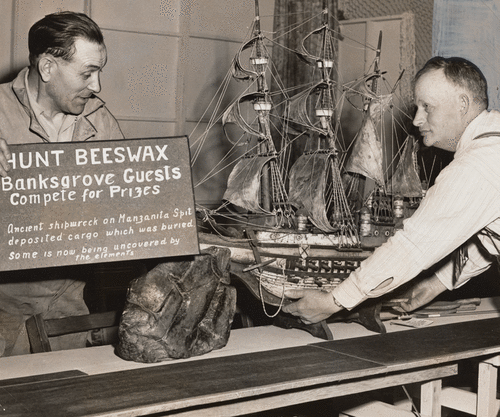
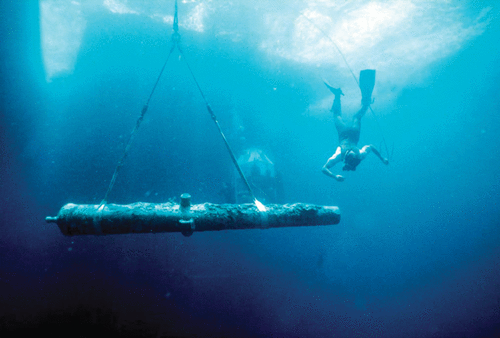
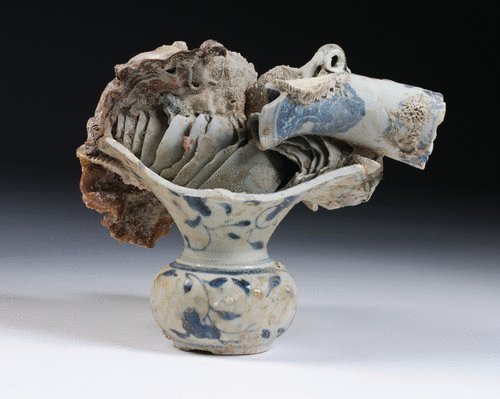
If one were to seek a through line with respect to the flotsam economies occasioned by the Santo Cristo de Burgos, the arbitration of cargo value would be a real contender. This is true of any shipwreck recovery. As the Santo Cristo de Burgos makes plain, the process can be productively estranging in scumbling truisms about commodity flows and goods: porcelain became weaponry, wax became currency. No Clatsop or Nehalem-Tillamook person would have explained things in quite this way, but their use of porcelain and wax inverted traditional modes of colonial extractivism. Of course, the wax had itself been part of precisely such an economy, paid as tribute by Indigenous communities in the Philippines. But in contrast to all that was taken by force from Indigenous people in the Iberian Empire, the goods of the Santo Cristo de Burgos became—and should now be read—not only as water-bestowed windfall. They are also willfully chosen, foreign imports.
As so often happened in the Americas, Clatsop and Nehalem-Tillamook residents of the Oregon coast would eventually lose their land as the “usual” kind of settler colonialism closed in. The Santo Cristo de Burgos, however, insists we consider what happens in the “not yet” spaces of empire, spaces where colonial occupation had not yet occurred.45 In being in the wrong place at the wrong time, shipwrecks more generally require us to parse the interstitial, the places that fall outside the expected temporal and geographic coordinates of art historical looking with its presumptions about the proper locations of culture and creation. By shifting the desired trajectory of commodities and goods, shipwrecks alter traditional modes of valuation. Even more specifically, it is the act of recovery that reframes value, forcing objects into times and places where they must necessarily be reassessed. Although the point may seem simple, its implications are not: revaluation animates the possibility of historicizing estrangement. And by looking alongside period actors as they gauge salvaged objects, we get a new chance to consider just what is exceptional (or normative) to begin with.
Surplus Surfaced
The protracted surrender of early modern commodities onto the Oregon coast undermines any fantasy of complete recovery, a traditional component of so much shipwreck lore. In those versions of the story, one finds not remnants on the beach but entire pieces of a ship, with cargo still intact, in a place that divers can reach. A ship’s hull—large timber stretching across a sandy floor—is the gold standard for modern recovery projects, but waters must be both hospitable and clear to see these remnants.46 Another good diagnostic is a cannon. Early modern ships needed to protect themselves not just from rough seas but also from threats launched by pirates and buccaneers. For archaeologists, iron cannons can be an “X-marks-the-spot”: on the best of days a magnetometer might turn up a cannon shaft. The photograph in figure 11, which shows a cannon from the sunken galleon San Diego being lifted to shore, evocatively calls to mind early modern battle losses but also the remarkable extractions possible when archaeologists are both knowledgeable and lucky enough to find what they have sought.
The cannons of the Santo Cristo de Burgos have never been found. Oregon’s tides rip and pull, and the coast is dotted with tsunami warning signs for good reason. These waters threaten boats dedicated to modern recovery as much as they once did the lost galleon that archaeologists have endeavored to locate.47 The lack of a cannon and hence the ship’s hull—an absent presence at the bottom, somewhere, of the sea—is for some profoundly frustrating, and made even more annoying by the slow beaching of the galleon’s cargo. As some have argued, “the complexity of ships offers one of the best ways to access the past.”48 And so, along this coast, the Pacific taunts us almost enough to make us want to give up. Historians and treasure seekers may be seduced by the hunt, the hope of discovery, and the promise of pulling old things to shore. But the waves and flows that move sand up and down the Nehalem spit are so strong that some believe that the ship may well now be almost entirely dispersed.49
More than a few shipwreck dreams are fueled by a nostalgia for and romance around the natural work of the ocean. Yet for all its fluid wrath, the ocean can act as preservative, if not also creative agent of surplus in its own right. Shipwreck hunters would have us believe that this work is most entrancing when underwater beds lie undisturbed. Ocean surfaces can be flecked with whitecaps, but in deafeningly quiet waters below slow accretion can bind, even sediment, things in place. Writing about a stack of blue-and-white dishes found at the bottom of the sea within the wreckage of the Royal Captain, Frank Goddio describes the sea’s gentle touch, telling of porcelain “miraculously held unharmed.”50 While the merchants who lost these goods might argue the point, Goddio’s comment calls to mind the (somewhat ironically) stabilizing power of the ocean. This is an idea that many others have articulated. As Hugo Miguel Crespo notes in a recent exhibition catalogue about the Portuguese trade of jewels through the Indian Ocean, a shipwreck’s very meaning rests in its temporal stoppage, that one can understand global scales because the ship continues its journey into the present “delivering to us … their exact chronologic and geographic contexts as if some time capsule.”51 If we follow this thread, our attention becomes focused on presumed past realities: how things were packed for transport, how the particular shape of a ship’s hull was held together, how many different kinds of metal were sent from ocean to ocean, and how these and other durable objects were sent from port to port.52 Even after centuries on the ocean floor, objects seem to sit safely—despite the silt and sand, the algae and the coral.
Early modern time capsules tend to lead researchers toward archival deposits, where metaphors of frozen time also abound. When archives—rather than seabeds—become sites of research, distinct (although perhaps related) modes of recovery coalesce. Documents can allow us to “lock down” which ship went missing and when it was expected at shore, who commanded the vessel, and how many people registered as passengers, including which, if any, were enslaved. Yet the ocean can also renew the skeptic’s mistrust of writing and the institutions where old papers are held, for hundreds of things (and people) got put on ships without being inventoried, and paperwork tends to remain mute about cargo and contraband sitting side by side. While alignments between the written word and shipwreck are always satisfying, the material presence of objects on the seafloor entangles presumed hierarchies, making less certain what counts as trace, what as source.53
If the visuality and materiality of something like packed plates return us, if only imaginatively, to a past where things were still in motion, this is far from the full picture. One postdiscovery gesture, as with the emerald cross, is to restore an object to its condition pre-seabed. So expected are these practices of salvage and conservation, they seem ludicrous to question. After all, seeing jewelry glisten in an exhibition case can be a pleasure. This kind of restoration work places a premium on—and therefore often creates—a “start date”: namely, the moment objects began their seafaring journey. Consequently, the day an object was packed onto the ship comes to represent a prime moment, implying that life “before the wreck” was somehow better than after. The Clatsop and Nehalem-Tillamook arrowheads, however, make it clear that there are good reasons to throw such customary, if often unarticulated, narratives into question.
In theory, the export commodities loaded upon galleons were supposed to arrive largely unchanged, apart from a rise in their price due to transportation costs and the foreignness that infused objects as they traveled from port to port. Through a wreck, though, the sea can transform the ship into a generative site, one that sometimes yields more than what was first submerged. This may seem counterintuitive, because we—like early modern ship captains and financiers—tend to think of the oceans as forcing loss, dispersing things of value. Yet contemporary auctions and galleries trade on the connotative accretions of wonder and wealth that adhere to shipwreck finds: a bar of silver pulled from the Atocha off the coast of Florida will yield significantly more on the open market than its commodity price on any given day.54 This is certainly not because a hurriedly cast bar of silver is really much to look at; once shipwrecked, though, silver is clearly something special.
Shipwreck residue can also be much more literal. Erosion and shifting sands, chemical changes, animals and plants, and the sheer weight of water act on things. They often build them up. These underwater processes have been known to change materials into objects that pass as art, and rather more frequently than one might expect. We see an example of the agglomeration of the sea in another stack of porcelain dishes that was recovered from the Ca Mau, a Chinese junk that vanished around 1725.55 A fire, perhaps the one responsible for the wreck itself, seems to have melted the underglaze of these porcelain vessels. When water overwhelmed the ship, it quickly cooled this molten matter and fused the ceramics into an inseparable mass. This was not the end of their transformation: once underwater, these ragged agglomerations became hospitable receptacles to barnacles and bivalves. In figure 12, a large clam—its shell a wavy ripple—still clings to the wall of a flowerpot and nine fractured bowls. Turning this “sculpture” around exposes a poignant history: the once-living sea creature seems to have crawled into the broken porcelain, its porous structures accentuating the smooth surfaces and jagged edges of ceramic and thereby signaling multiple durational processes of facture. This kind of accretion represents the slow work of the ocean. Ceramic vessels played the role of host; in return, the shells of sea creatures roughened porcelain surfaces. Animal and mineral became one.
The Victoria and Albert Museum notes in the description of this work that it was “created through accident and nature.”56 Both are forces that art history, at least in its classical incarnations, tends to sideline, for the discipline is not well equipped to handle oceans or fires—intentionless entities and forces—as makers of art. In the case of this vessel, where would creative gestures be fixed? How would one date this piece? And if one wanted to name some of its human creators, would the captain of the sunken ship count among them?
If this object invites thinking about co-creation, this is just the beginning. Art history, after all, has a significant investment in authorial agency. Offering the sea a share in the creative process complicates tidy demarcations for interpretation. Seen in this light, shipwrecks require us to nuance (if not entirely reconstrue) how and what constitutes “the making of art.” They also call for some reckoning around where art history tends to look for—if not expect to find—the creative process taking place.57
It is tempting to view wrecks largely as a happenstance of preservation rather than a productive site in their own right. And indeed there are many precious, art-historically familiar things that come to us intact because of shipwrecks. However, since there is no restoration work that can undo this porcelain object’s underwater life, there is also no way to extract this object (or set of objects) from its shipwreck history. This sea sculpture shifts us outside the poles of preservation and fragmentation occasioned by disasters at sea. Instead, the composite porcelain and clamshells signal something else. The ocean did not merely make this object; it made it more than the sum of its parts. And in this, the sculpture—and the site of the shipwreck, more generally—moves us beyond wholeness to excess.
That potential for surplus production has been capitalized upon by a number of recent art projects.58 Damien Hirst, in his 2017 exhibition for the Venice Biennale, Treasures from the Wreck of the Unbelievable, captures the affect that adheres to shipwrecked goods more explicitly, if also more facetiously, than nearly any other artist working underwater.59 Hirst’s show had plenty of fans and just as many detractors. Yet one cannot deny how strategically his project mobilized the ocean’s accretive possibilities, as signaled by a photo of his sculpture Hydra and Kali sitting on the seafloor before it was exhibited (fig. 13). Prior to surfacing at the Biennale, the over-life-size casting had been submerged for nearly a decade off the coast of Zanzibar, where Hirst asked both water and animals to go to work.60 Currents were expected to deposit the eggs of bivalves and the beginning of coral outcroppings, then nourish these colonies with briny flows.
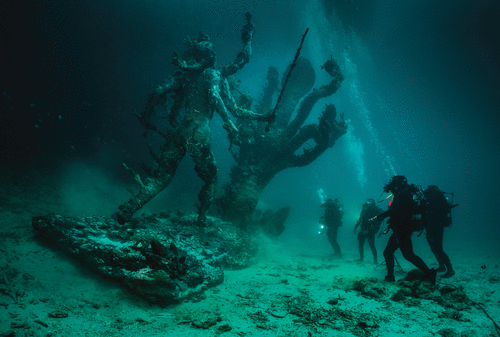
There are so many “unbelievable” things in Hirst’s staging of “shipwreck” remains, but perhaps nothing so much as the temporality of the endeavor. There is the patient waiting game, to be sure. Yet in both style and iconography, his statues also dissimulate. The ship was said to have sunk nearly two millennia ago, but clearly the ocean did not have that kind of time. The statues have hardly decayed; their faux-classical musculature remains visible, taut under smooth, uncorroded skin (fig.14). The scattered pieces of stag coral that affixed themselves to sculpted bodies must certainly be considered surplus, though they are just the beginnings of what the ocean would create if it had its way. For this art, there was precious little accident: someone watched the clock, deciding just how long was time enough for nature to create the spiny, coarse accidents that Hirst hoped for (or could tolerate).61
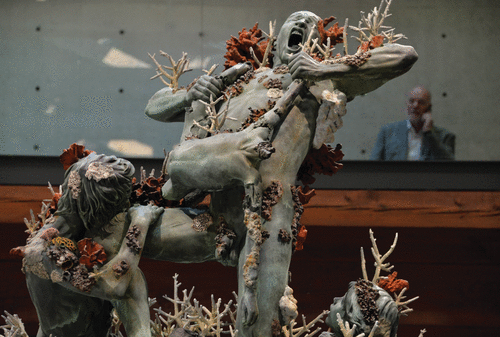
Hirst and his collaborators also pulled the bottom of the ocean into the infrastructure of the project by staging—and pretending to document—a nearly complete recovery. Indeed, one of the most effective, if also trite, aspects of Hirst’s Treasures from the Wreck of the Unbelievable is the impression it gives that he and his team identified and then dutifully checked all the boxes on a list of shipwreck tropes. These tropes have been well polished by History Channel documentaries, auction-house hype, and the scholarly fields of history, archaeology, and maritime studies for which the shipwreck has long been a critical site of research. In all this, photography played a significant role, dramatizing the wonderment of a seemingly surprise underwater encounter (see fig. 13). The semidarkness, the uneven seabed, the divers’ bubbling breath coalesce into a scene of otherworldly marvel. The excavation of nearly every wreck now trades in this visual currency, as the photograph of the cannon lifted from the San Diego makes clear. Discovery encounters staged for (if not through) the camera fuse an object’s underwater history to its life above the waves. Such images—it turns out—form another way of producing oceanic surplus, something Hirst played up by littering photos of his discovered objects throughout his exhibition and putting a collection of them on sale.62
The pictorial reproduction and valuation of accretions from the sea that build up in and around the products of human manufacture are not purely contemporary phenomena. Nor is the notion of thinking through, rather than strictly about, salt water. Take, for instance, a printed plate from Hans Sloane’s 1707 account of his voyage through the Caribbean (fig. 15). A large outgrowth of coral, along with a few circular objects and a man-o’-war span the two-page spread. The venomous sea creature, with its spindly tentacles, lends the image a sense of watery life, and the Latin labels declare that all else shown here was recovered from a Spanish shipwreck (the so-called Plate-Wreck) off the coast of Hispaniola in 1687.63 The shaft of coral almost, but not quite, conceals the contours of an iron bolt that formed part of that ship’s rigging. And the other, misshapen lumps are encrusted coins, so-called pieces of eight. Although he was not an eyewitness to the recovery, Sloane’s text reports two campaigns of salvage work; more to the point, he stresses a principal interest in the accretions that had occurred around material both prized and quotidian: “The Pieces of Eight in the Silver-Wreck … were covered with this [Coralline] Matter about a quarter of an Inch thick, and I have a piece of the Timber of the Ship, with an Iron Bolt in it, grown over with the Corallium candiican adulterium.”64
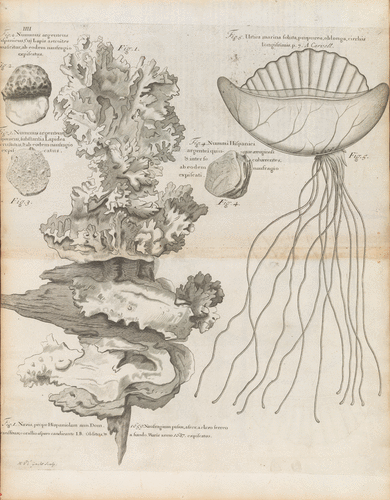
In this print, sea life still clings to the coin at top left, a crystalline outgrowth having mushroomed off its thin edge. Floating between coral column and man-o’-war is more silver; in this case, the ocean’s currents made no deposits but fused a stack together with verdigris. Much like the oddly shaped wax blocks from the Santo Cristo de Burgos, these objects hover between the manufactured and the natural. This was just as Sloane wanted it. He was not desirous of silver to melt down and put back into circulation; rather, these wrecked goods—including objects as utilitarian as an iron bar—held his interest for what they had accrued in their roughly thirty years below the ocean’s surface.65 In Sloane’s collection, these items were sorted and inventoried in a “Catalogue of Fossils including Coralls, Serpents, Echini, Crustacea, Starrfishes, Humana,” that is to say: valued and categorized not for what they once were but for what they had become and now played host to.66 In picturing them with a sea creature, Sloane reminds us of their underwater sojourn and proffers a clever pun to evoke the ship and its fate—the moniker “man-o’-war” having come from the name given to heavily armed Portuguese vessels because of a homologous boatlike shape and capacity to float along the currents.
The transformation narratives that adhere to the Hirst works, the porcelain sea sculptures of the type held by the V&A, and the objects of Sloane’s collection invent one kind of shipwreck time by visualizing the interval in which accretions occur. These temporal conditions are decidedly different from those which can be described for the porcelain arrowheads and the wax blocks we know from the Santo Cristo de Burgos. While the sea sculptures materialize the indelible marks of a shipwreck, the arrowheads point, instead, to willed re-formation on land. The remaking was made possible, of course, because of the serendipitous and persistent offering of ceramic fragments made by the sea. Wax blocks and the many other unworked porcelain fragments from the Santo Cristo de Burgos that continue to surface thus open onto yet another kind of narrative duration—one that is both longer and shorter than that of the arrowheads. For all this still-unworked flotsam, the shipwreck remains in process, three hundred years after the galleon first foundered. Their temporality is as arrested as it is continuous: a slow spit from the sea.
Colliding temporalities require different ways of valuing objects and materials. The time-capsule metaphor opens fairly obviously onto microhistories that archival research might well complete. In sustaining this metaphor to frame objects for consumers, museums and auction houses tend to reassert these narratives as normative. But wrecks accord with a broader span of temporal logics. It is in this window that the V&A sea sculpture, Sloane’s collection, and the Hirst exhibition complicate matters. For all refuse to let go of the longue durée. Even the Santo Cristo de Burgos, so unremittingly fragmentary, plays a role here. Its temporal overdrives come from a seemingly inexhaustible hull that refuses to stop offloading onto the Oregon coast. This all exerts considerable interpretive pressure, imploring art history to attend more generously to the surpluses that oceanic temporalities create. As many a sailor would tell you, even a day can be long at sea.
Are We All Watery Now?
Some may find the task (let alone the challenge) of thinking with shipwrecks indulgent. We respectfully disagree. And so in closing, we suggest that not only is it worth the effort but that we find ourselves in a particularly pressing time for such work. Indeed, shipwrecks open onto issues that have become ever more difficult to set to the margins—in art history and the humanities more broadly, along with fields beyond the humanities entirely.
Beginning with art history, shipwrecks make it impossible to ignore the globalizing momentum of the discipline across the last three decades. Even if the ship still often sits (or bobs and sways) out of frame in many such histories of early modern art, it could serve as an emblem for this still-burgeoning field of inquiry. The “global list”—an often run-on sentence about the goods carted from here to there, there to here—has come to feel nearly de rigueur when discussing art produced in a global framework, whether in the Renaissance or the long eighteenth century. Of course, the ship was a prime mechanism of transport. Without ships, there would have been much more limited mobility, less entanglement across long distances. There might well have been much less colonialism and far less slavery.67 It therefore seems quite the contradiction that art history has been so reluctant to take the fate of ships—as opposed to their images and cargo—more seriously.68
The shipwreck forces the issue, asking us to account for mobilities and immobilities of more than one sort by pausing transit, for despite the potency of the time-capsule metaphor, the ocean tends to have its way with things. And this long process, the work of the sea, introduces both co-presence and co-creation, neither of which should be discounted. Water’s metric tonnage has its consequences: Does cultural or artistic agency really lie so resolutely within the domain of the human? What kinds of creating require greater acknowledgment than they have received? And how then might colonial histories specifically—which rest upon more than a few shipping projects and wrecks—allow us to rethink what it means to make things worth saving?
Asking and attempting to answer these questions, at the site of the shipwreck, suggestively aligns global art history with the discipline’s newer ecocritical directions. Carving out a place for the visual arts and its interpreters within a broader space of natural forces is no small part of the project of ecoaesthetics, which seeks to pull ecological processes into art history’s domain. The promise of this work stretches beyond centering “nature” and its effects; it aims instead to forge ways of thinking art, objecthood, and materiality so as to include ecologies of all types as key participants.69 While the returns on such investments are just now registering, and while shipwreck histories could well contribute to methodological projects of this type, our larger point is not simply that “shipwreck thinking” finds some kin in ecoaesthetics. Rather, in exposing analytic pressure points, the shipwreck begs for sharper tools to think about preservation and loss, decay and contingency—a point extendable from a ship sunk at sea to, for instance, a fire-ravaged monastery sequestered in mountain peaks or a private collection shaken by earthquake in an urban townhouse.
Even so, the ocean is a particular kind of place. Outside art history, scholars in the humanities have ardently embraced oceans as site, context, and metaphor, often working under the rubrics of the blue humanities and the oceanic turn. These discursive shifts draw attention increasingly away from land-based histories and center instead the terraqueous.70 And this, it would seem, is exactly a realm where shipwrecks should matter—a point underscored by a recent proposal that the early modern period be considered a Naufragocene.71 But blue humanist ambitions extend quite a bit further. As Laura Winkiel has recently written in something of a state-of-the-field address, “In the past few decades oceanography, geophysics, and evolutionary and marine biology have drawn our attention down to the smallest units of the microbial seas … and upward to a scale of millions of years of evolution. The result of this scientific calibration along inhuman scales has been a reconceptualization of what life is and where it occurs.”72 There is obvious political urgency to this kind of thinking with water. We certainly understand the impulse: the Anthropocene looks to have a bleak future, so much so that holding on to traditional thinking and conceptual framing is for many becoming (if it has not already become) an unsustainable luxury.
With this latter point, it would seem hard to register much legitimate dissent. And yet, the sunken ship grates. As scholars of colonial histories, we are decidedly primed to the fact that wreckage has served as a key concept for the ways that colonialism has left its mark.73 One might take or leave that view as defeatist or pernicious, but it reminds us of the prices paid (very dearly by some) in the wake of imperial projects. To our eyes, posthuman thinking—even when gently advocating for co-constitution—risks muddling the damage wrought by humans, diluting questions of responsibility.74 While few would argue that every human actor has played a similar role in bringing us to the present brink, post-Anthropocenic frames, at their most expansive, redirect attention in ways that obscure, repress, or erase some of humanity’s most disquieting acts. Setting imperial projects—still too caustic, still too poorly grappled with, even as their power to shape the present endures—into geologic and oceanic time has the potential of turning tragic parts of history into little more than a sliver or a blip within an already slender human past: a moment within a moment that passes in a flash.75
To be sure, the sunken ship pulls cultural frames of reference and histories of human making ever closer to the epistemologies, if not the literal substance, of salt water. And maybe we really are all watery now. But as our reading of the remnants of wreckage suggests, we have our doubts; and we see a need for recalibrating the colonial within posthuman frameworks. Given its imperialist underpinnings, this would admittedly not seem to be art history’s strong suit. However, there might be something to say for deep investments in, even compulsions toward, microhistories of authorship, agency, and reception. By refusing to give up on humans and their work in the world, art history—nearly in spite of itself—cracks open a door for keeping colonialism in play, and with that, for attending to how colonialism created certain kinds of humanity in the first place. Yet any serious art history of the wreck (if such a thing came to exist) would require accounting for duration, contingency, and disaster in ways that tax the humanities’ traditions. We end up, then, with the shipwreck as something of a test case for just how blue art history—or really, any discipline committed to human creativity—might ultimately become. We may be alone in this, but we think this test is one worth confronting, one demanded by the watery world that rightly unnerves but seduces us all.
Aaron M. Hyman is assistant professor in the department of the history of art at Johns Hopkins University, Baltimore. Currently, his research is supported by a Marilynn Thoma postdoctoral fellowship from the Carl & Marilynn Thoma Foundation.
Dana Leibsohn is Alice Pratt Brown Professor of Art and director of the program in Latin American and Latino/a studies at Smith College, Northampton, Massachusetts.
We thank those who shared their expertise in Oregon: Thomas Campbell, Ruby Fry-Martin, and Jeff Smith facilitated collections research; and Scott Williams helped us get our bearings and was generous with his knowledge. Coll Thrush was an early, important interlocutor. Nancy Um and Allison Stielau offered ideas about shipwrecked ceramics and silver. Pieces of this essay were presented at the John Carter Brown Library, the University of Colorado, and Denver University; our gratitude goes to colleagues in those settings for pushing our thinking, and especially Neil Safier, James Cordova, and Donna Beth Ellard for inviting us to speak. For advice while writing, we thank Emily Casey, Yanlong Guo, Christopher Heuer, John McAleer, and Marcy Norton; also the outside reviewers of West 86th. Funding for research came from Johns Hopkins University and Smith College. For help preparing several images, we thank Lael Ensor-Bennett. Unless noted, translations are our own; so too are any mistakes.
- 1 Drawings of this suit (called a “Máquina Hydroándrica”) and accompanying explanations are now held in the Archivo General de Indias, Consejo de Indias, MP-INGENIOS, 248–51. See also El oro y la plata de las Indias en la época de los Austrias (Madrid: Fundación Ico, 1999), 696, cat. 168.
- 2 Cited in Lisa Han, whose interests in theories of salvage connect Virilio’s idea about innovations that precipitate disaster to the interpretive challenges posed by the inevitability of loss and the predictability of failure. Lisa Han, “The Blue Frontier: Temporalities of Salvage and Extraction at the Seabed,” Configurations 27, no. 4 (2019): 463–81, particularly 468.
- 3 His was not the first diving design to circulate in the Iberian world: ideas for underwater diving apparatuses and salvage techniques date from at least the late sixteenth century. See, for instance, El oro y la plata, 696, cat. 167; Pedro de Ledesma, “Description of Seven Salvage Techniques,” ca. 1623, Cátedra de Historia Naval, Universidad de Murcia, https://catedranaval.files.wordpress.com/2014/09/manuscrito_de_ledesmaoriginal.pdf. For an overview of earlier inventions, see Fernando Serrano Mangas, Naufragios y rescates en el tráfico indiano en el siglo XVII (Madrid: Sociedad Estatal Quinto Centenario, [1991?]), 117–29.
- 4 See, for instance, Richard Gould, ed., Shipwreck Anthropology (Albuquerque: University of New Mexico Press, 1983), and more recently, Amaru Argüeso and Nicolás Ciarlo, “Fieldwork Methodology in South American Maritime Archaeology: A Critical Review,” Journal of Marine Archaeology 12 (2017): 179–97. For an example of exploratory techniques that involve GIS, acoustic imaging, and magnometry, see, for instance, Joseph Breman, “Marine Archaeology Goes Underwater with GIS,” Journal of GIS in Archaeology 1 (2003): 24–32; Gaia Mattei and Francesco Giordano, “Integrated Geophysical Research of Bourbonic Shipwrecks Sunk in the Gulf of Naples in 1799,” Journal of Archaeological Science 1 (2015): 64–72.
- 5 The San Diego, a Spanish galleon repurposed for military battle, sank near Fortune Island, not far from Manila, in 1600. These are two of the many hundred porcelain vessels recovered from the wreck during excavations in 1991–93. Piezas arqueológicas de la nao San Diego en el Museo Naval de Madrid (Madrid: Museo Naval, 1999), 4.
- 6 Scott S. Williams, personal communication, January 13, 2020. Porcelain sherds are also known from coastal California (Drake’s Bay) and the Baja Peninsula. See, for instance, Edward P. Von der Porten, Ghost Galleon: The Discovery and Archaeology of the San Juanillo on the Shores of Baja California (College Station: Texas A&M University Press, 2019).
- 7 On porcelain shipments from Manila to New Spain, see María Bonta de la Pezuela, Porcelana china de exportación para el mercado novohispano: La colección del Museo Nacional del Virreinato (Mexico City: Universidad Nacional Autónoma de México, 2008). And for an evocative discussion on the unexpected circulation of early modern Chinese porcelain sherds in a very different setting, see Anne Gerritsen on the contemporary sherd market in Jingdezhen: The City of Blue and White: Chinese Porcelain and the Early Modern World (Cambridge: Cambridge University Press, 2020), 17, 227–32.
- 8 It remains possible that this ship had another name; however, in this essay we follow the archival and archaeological research of Scott Williams and his collaborators. Scott S. Williams, “The ‘Beeswax Wreck’: A Manila Galleon on the North Oregon Coast,” Alaska Journal of Anthropology 15, nos. 1/2 (2017): 79–87.
- 9 Cameron La Folette and Douglas Deur, “Views across the Pacific: The Galleon Trade and Its Traces in Oregon,” Oregon Historical Quarterly 119, no. 2 (2018): 160–91, specifically 169–70. For written accounts that register Indigenous memories of shipwrecked Europeans who made it to shore and their descendants, see Warren Cook, Flood Tide of Empire: Spain and the Pacific Northwest, 1543–1819 (New Haven, CT: Yale University Press, 1973), 32–38.
- 10 Curt D. Peterson, Scott S. Williams, Kenneth Cruikshank, and John Dubé, “Geoarchaeology of the Nehalem Spit: Redistribution of Beeswax Galleon Wreck Debris by Cascadia Earthquake and Tsunami (~AD 1700), Oregon, USA,” Geoarchaeology: An International Journal 26, no. 2 (2011): 219–44.
- 11 On Indigenous responses to these events, as reconstructed through archaeology and ethnohistory, see Robert Losey, “Communities and Catastrophe: Tillamook Response to the AD 1700 Earthquake and Tsunami, Northern Oregon Coast” (PhD diss., University of Oregon, 2002).
- 12 The literature on these themes is extensive and growing. For a sense of the range, see Josiah Blackmore, Manifest Perdition: Shipwreck Narrative and the Disruption of Empire (Minneapolis: University of Minnesota Press, 2002); Jennifer L. Roberts, “Copley’s Cargo: Boy with a Squirrel and the Dilemma of Transit,” American Art 21, no. 2 (2007): 20–41; Geoff Quilley, Empire to Nation: Art, History and the Visualization of Maritime Britain, 1768–1829 (London: Paul Mellon Centre, 2011); Celeste-Marie Bernier, “‘The Slave Ship Imprint’: Representing the Body, Memory and History in Contemporary African American and Black British Painting, Photography, and Installation Art,” Callaloo 37, no. 4 (2014): 990–1002; Peter C. Mancall and Carole Shammas, eds., Governing the Sea in the Early Modern Era: Essays in Honor of Robert C. Ritchie (San Marino, CA: Huntington Library, 2015).
- 13 Some of this labor would have been performed by enslaved people; trans-Pacific slavery ended ca. 1660 (by law if not in practice). Tatiana Seijas, Asian Slaves in Colonial Mexico: From Chinos to Indians (Cambridge: Cambridge University Press, 2014), particularly 98–108.
- 14 Folette and Deur, “Views across the Pacific,” 174–81.
- 15 On the archival identification of the ship and an overview of the site, history, and recovered objects, see Scott S. Williams, “The Beeswax Wreck, a Manila Galleon in Oregon, USA,” in Early Navigation in the Asia-Pacific Region, ed. Chunming Wu (Singapore: Springer, 2016), 147–67; Williams, “‘Beeswax Wreck,’” 79–87.
- 16 Wax blocks weighing up to eighty kilograms were said to be found on the Nehalem spit. Peterson et al., “Geoarchaeology of the Nehalem Spit,” 221. As many as twelve tons of recovered wax were reportedly transported from the Nehalem coast in the nineteenth century to markets elsewhere in Oregon, California, and Hawaii. Williams, “Beeswax Wreck” (2016), 159. While the survival of wax blocks is not well known, some have also been found along the Baja coast (Mexico), likely from the wreck of the galleon San Juanillo. Von der Porten, Ghost Galleon, 84, 88, particularly 113–14.
- 17 S. J. Cotton, Stories of Nehalem (Chicago: M. A. Donahue, 1915), 52.
- 18 On Spanish colonial use of American wax, see Donald D. Brand, “The Honey Bee in New Spain and Mexico,” Journal of Cultural Geography 9, no. 1 (1988): 71–82; Geoffrey H. Wallace, “The History and Geography of Extraction Production in the Northern Maya Lowlands, 1540–1700” (PhD diss., McGill University, 2020), 140–224. Apart from candles for Catholic rituals, there were other uses for wax in the Americas (as in Europe): in producing everything from etching grounds to lost-wax casting forms and waterproof patching. The primary intent of trans-Pacific wax, however, involved objects crafted for use in spiritual economies.
- 19 Some wax also came from Africa; on wax use in the Americas and Senegambian production, see Linda A. Newson, “Piety, Beeswax and the Portuguese African Slave Trade to Lima, Peru, in the Early Colonial Period,” Atlantic Studies 16, no. 2 (2019): 144–62. Wax may also have been imported from Indonesia to the Philippines before being shipped across the Pacific. Von der Porten, Ghost Galleon, 162.
- 20 Manuel Carrera Stampa, Los gremios mexicanos: La organización gremial en Nueva España 1521–1861 (Mexico City: Ibero-Americana de Publicaciones, 1954). For an example of wax regulations in Mexico City, see the 1574 “Ordenanzas para el officio de cereros,” in Legislación del trabajo en los siglos XVI, XVII y XVIII: Relación entre la economía, las artes y los oficios en la Nueva España (Mexico City: D.A.P.P., 1935), 28–31.
- 21 We mean this most literally. While others have mused on the intoxicating scents of old documents, this is not quite the same thing. Neither are reconstructions of historical smellscapes. For an example of the latter in the contemporary art world, see Beatrice Glow’s Aromérica Parfumeur, installation at Sala de Arte del Museo Nacional de Bellas Artes de Chile en Mall Plaza Vespucio, 2016.
- 22 On the local, colonial matrix of production and meanings of both emeralds and cross, see Tom Cummins, “They Esteem Emeralds Even More Than Gold: Muiscas, Spaniards and Objects of Value,” in Portable Universe / El universo en tus manos: Thought and Splendor of Indigenous Colombia (Los Angeles: Los Angeles County Museum of Art, forthcoming). We thank Tom Cummins for sharing this article. Publications on Nuestra Señora de Atocha tend to highlight the drama of the search for the lost galleon and its treasure. See, for instance, R. Duncan Mathewson III, Treasure of the Atocha: Sixteen Dramatic Years in Search of the Historic Wreck (London: Sidgwick & Jackson, 1986); Eugene Lyon, Search for the Motherlode of the Atocha (Port Salerno: Florida Classics, 1989).
- 23 Kris Lane, Colour of Paradise: The Emerald in the Age of Gunpowder Empires (New Haven, CT: Yale University Press, 2010).
- 24 On strapwork and its export potential, see Christopher P. Heuer, The City Rehearsed: Object, Architecture, and Print in the Worlds of Hans Vredeman de Vries (London: Routledge, 2009), 99–135; Santiago Sebastián, “La decoración llamada plateresca en el Mundo Hispánico,” Boletín del Centro de Investigaciones Históricas y Estéticas 6 (1966): 61–80.
- 25 For a pairing of a similar emerald cross with an Antonio Moro painting, see Priscilla E. Muller, Jewels in Spain: 1500–1800, 2nd ed. (New York: Hispanic Society of America, 2012), 66–67. On jewelry more broadly in the early modern Iberian world, see Letizia Arbeteta, “La joyería: Manifestación suntuaria de los dos mundos,” in El oro y la plata, 425–49.
- 26 On the recursive validation of ornament and art, and on art’s capacity to move the real jewel toward the ideal, see Marcia R. Pointon, “Peter Paul Rubens and the Mineral World,” Artibus et Historiae 79 (2019): 229–65.
- 27 Shipwreck artifacts have the reputation of being among the most conservation intensive of all archaeological remains. And some people have argued it is unethical to excavate shipwrecks at all, especially if no conservation is intended or can be afforded. See, for instance, George Bass, “The Ethics of Shipwreck Archaeology,” in Ethical Issues in Archaeology, ed. Larry Zimmerman, Karen Vitelli, and Julie Hollowell-Zimmer (Walnut Creek, CA: Altamira Press in conjunction with the Society for American Archaeology, 2003), 65–66.
- 28 This question, we presume, would be posed otherwise by a design historian or an archaeologist invested in material culture and its histories. And this speaks to our point: disciplines, even when allied, make quite different decisions about “what counts as worthy.”
- 29 Our point is a relative one: once wax has been transformed into a death mask or anatomical model, it tends to become more interesting—both aesthetically and phenomenologically—to art history.
- 30 Writing about shipping practices more broadly, Nancy Um makes a similar point, urging art historians to look beyond the “world of the precious.” Shipped but Not Sold: Material Culture and the Social Protocols of Trade during Yemen’s Age of Coffee (Honolulu: University of Hawai‘i Press, 2017), 148.
- 31 Edward Von der Porten speculates that the wax may have been shipped from the Philippines in two standard sizes. Ghost Galleon, 113.
- 32 Wax as a substance, we would suggest, offers us a window onto other shipwrecked substances to which art history has paid little attention. Some cognate early modern commodities that come to mind: residue of wine, perfume, oil, whale oil, tobacco, spices.
- 33 For an apposite case in which shipwrecked objects (in this case prints) shuttle between commodity and art object in both physical form and conceptual, art historical classification, see J. Braat, J. P. Filedt Kok, J. H. Hofenk de Graff, and P. Poldervaart, “Restauratie, conservatie, en onderzoek van de op Nova Zembla gevonden zestiende-eeuwse prenten,” Bulletin van het Rijksmuseum 28, no. 2 (1980): 43–79; Christopher P. Heuer, Into the White: The Renaissance Arctic and the End of the Image (New York: Zone, 2019), 134–43.
- 34 In the Spanish Americas, particularly in the Caribbean, the expertise of enslaved divers of African and Indigenous descent was highly valued. The wreck of the Nuestra Señora de Atocha, for instance, was salvaged in part by bondsmen. In at least a few cases, documents suggest that some of the silver brought to shore by enslaved divers could be used to purchase freedom. See, for instance, Kevin Dawson, Undercurrents of Power: Aquatic Culture in the African Diaspora (Philadelphia: University of Pennsylvania Press, 2018), 73–77, 85–96; Molly Warsh, “Enslaved Pearl Divers in the Sixteenth Century Caribbean,” Slavery and Abolition 31, no. 3 (2010): 345–62.
- 35 For a sense of the different ways that multiethnic salvage operations might unfold, see, for instance, J. Barto Arnold III, ed., Documentary Sources for the Wreck of the New Spain Fleet of 1554, trans. David McDonald (Austin: Texas Antiquities Commission, 1979), particularly 148–89; Peter Bradley, “The Loss of the Flagship of the Armada del Mar del Sur (1654) and Related Aspects of Viceregal Administration,” Americas 45, no. 3 (1989): 383–403; Serrano Mangas, Naufragios y rescates; Genoveva Enríquez Macías and Victoria Stapells Johnson, “El Soberbio: Naufragio y rescate de un navío en el siglo XVIII,” Revista de Historia Naval 93 (2006): 33–56; Alejandra Dubcovsky, “When Archaeology and History Meet: Shipwrecks, Indians and the Contours of the Early-Eighteenth-Century South,” Journal of Southern History 84, no. 1 (2018): 39–68.
- 36 For New Mexico, see Donna Pierce, “Popular and Prevalent: Asian Trade Goods in Northern New Spain, 1590–1850,” Colonial Latin American Review 25, no. 1 (2016): 77–97; on Alabama, see Linda Shuksky, “Chinese Porcelain at Old Mobile,” Historical Archaeology 36, no. 1 (2002): 97–104. On the case of the Cora cacique Tonati, see Gustavo Curiel, “Customs, Conventions, and Daily Rituals among the Elites of New Spain: The Evidence from Material Culture,” in The Grandeur of Viceregal Mexico: Treasures from the Museo Franz Mayer (Houston: Museum of Fine Arts, 2002), 23–43, particularly 30. For Georgia, see William Hampton Adams and Sarah Jane Boling, “Status and Ceramics for Planters and Slaves on Three Georgia Coastal Plantations,” Historical Archaeology 23, no. 1 (1989): 69–96.
- 37 M. S. Jessica Lally, “Analysis of the Beeswax Shipwreck Porcelain Collection in Oregon, USA,” in Wu, Early Navigation, 169–94. These are not the only such points; others of Chinese porcelain have been found in archaeological settings on the north Oregon coast. Jon Erlandson, Robert Losey, and Neil Peterson, “Early Maritime Contact on the Northern Oregon Coast: Some Notes on the 17th Century Nehalem Beeswax Ship,” in ‘Telling Our Stories’: Proceedings of the Fourth Annual Coquille Cultural Preservation Conference, ed. Jason Younker, Mark Tveskov, and David Lewis (North Bend, OR: Coquille Indian Tribe, 2001), 45–55, particularly 48.
- 38 One could, for instance, put them into dialogue with porcelain remade via cutting and mounting in Europe, as described in Kristel Smentek, Rococo Exotic: French Mounted Porcelains and the Allure of the East (New York: Frick Collection, 2007).
- 39 Alejandra Dubcovsky argues that it is often “easier” to disassociate Indigenous from imperial histories, especially when it comes to shipwreck salvage histories. “When Archaeology and History Meet,” 43.
- 40 Alexander Henry and David Thomas, New Light on the Early History of the Greater Northwest: The Manuscript Journals of Alexander Henry and of David Thompson …, vol. 2, ed. Elliott Coues (London: Suckling, 1897), 841.
- 41 Clara Pearson in Erlandson, Losey, and Peterson, “Early Maritime Contact,” 50.
- 42 Henry and Thomas, New Light, 878.
- 43 See, for instance, George Quimby, “Trade Beads and Sunken Ships, in Archaeological Essays in Honor of Irving Rouse, ed. Robert Dunnell and Edwin Hall (New York: Mouton, 1978), 231–46, especially 233. In Nehalem Bay specifically, glass trade beads have been found archaeologically, in sites likely dating from the early to mid-eighteenth century. Losey, “Communities and Catastrophe,” 545.
- 44 Ben Lane, Manzanita Beach (Manzanita: Chamber of Commerce, 1930). We consulted a copy of this pamphlet at the Nehalem Valley Historical Society.
- 45 One could make a similar point about the East Indiamen that were wrecked around the southern coasts of Africa on their return from Asia. We thank John McAleer for drawing our attention to this parallel.
- 46 Along with information about ship-building technologies and knowledge transfer, the hull of a wrecked ship can, in certain instances, offer crucial clues about the site of the ship’s origin, if not also the ship’s cultural affiliation(s). See, for instance, Ricardo Borrero, “Archaeology of 17th-Century Iberian Shipwrecks: Reassessment and Comparison of Excavated, Recorded, and Published Hull Remains,” International Journal of Nautical Archaeology 49, no. 1 (2020): 155–78; Matthew Harpster, “Shipwreck Identity, Methodology and Nautical Archaeology,” Journal of Archaeological Method and Theory 20 (2013): 588–622.
- 47 Scott S. Williams, personal communication, January 13, 2020.
- 48 Jonathan Adams, “Ships and Boats as Archaeological Source Material,” World Archaeology 32, no. 3 (2001): 292–310, particularly 304.
- 49 Mark Beach, personal communication, January 16, 2020.
- 50 Frank Goddio, Discovery and Archaeological Excavation of a 16th Century Trading Vessel in the Philippines (Lausanne: World Wide First, 1988), 2. N.b.: This ship, a British Indiaman, sank in the South China Sea in 1773.
- 51 Hugo Miguel Crespo, Jewels from the India Run (Lisbon: Fundação Oriente, 2015), 174–75. Pressing against the time capsule metaphor, however, others suggest it is more productive (and accurate) to develop reconstructive projects that focus upon the “relationships among objects, assemblages and structures.” Elizabeth Greene, Justin Leidwanger, Richard Leventhal, and Brian Daniels, “Mare Nostrum? Ethics and Archaeology in Mediterranean Waters,” American Journal of Archaeology 115, no. 2 (April 2011): 311–19, particularly 312; see also Adams, “Ships and Boats.”
- 52 For a paradigmatic discussion, particularly about ship typology, see Cheryl Ward, “The Sadana Island Shipwreck: An Eighteenth-Century AD Merchantman off the Red Sea Coast of Egypt,” World Archaeology 32, no. 3 (2001): 368–82. One can also see how ships navigated the waters: Filipe Castro, Nicholas Budsberg, James Jobling, and Amber Passen, “The Astrolabe Project,” Journal of Maritime Archaeology 10, no. 3 (2015): 205–34.
- 53 For discussion of the relationships between archaeological excavation and archival documents that characterize recent work in nautical archaeology, see, for instance, Harpster, “Shipwreck Identity.” For earlier perspectives on archives, artifacts, and methods of interpreting shipwrecks, see the essays in Gould, Shipwreck Anthropology. To the best of our knowledge, in art history (as opposed to archaeology), neither methodological nor theoretical discussions of the role of the archive vis-à-vis that of the find site or even shipwrecked artifacts excavated are well developed.
- 54 See, for instance, auction announcements by Jeff Stark, “82-Pound Silver Bar from Famed Shipwreck for Sale,” World Coins 28 (October 2016), and “Atocha Silver Bar among Sedwick’s May Auction Lots,” World Coins 25 (March 2017).
- 55 For basic information on this particular object, see “Sea Sculpture,” accessed July 3, 2020, http://collections.vam.ac.uk/item/O172836/sea-sculpture-unknown/. On the relevant auction lot, see Marcus Linell, “Sotheby’s Amsterdam: Made in Imperial China; 76,000 Pieces of Chinese Export Porcelain from the Ca Mau Shipwreck, circa 1725 on January 29th–31st, 2007,” Arts of Asia 37 (2007): 131.
- 56 “Sea Sculpture.”
- 57 For an ecoaesthetically driven version of a related point, see Sugata Ray and Venugopal Maddipati, eds., Water Histories of South Asia: The Materiality of Liquescence (Milton, UK: Taylor & Francis, 2019).
- 58 In addition to the Hirst discussed here, the work of Jason deCaires Taylor also comes to mind. Robert Preece, “Submerged: A Conversation with Jason deCaires Taylor,” Sculpture 35, no. 9 (2016): 18–23. For an artist tapping metaphors of suspension, see the work of Megan Fernandes, “Artist Statement: ‘The Poetics of Suspense,’” Configurations 27, no. 4 (2019): 545–60.
- 59 The show, which among other things staged the recovery of artifacts supposedly lost in the wreckage of a ship owned by a wealthy freed slave of Antioch, was accompanied by a catalogue with underwater-archaeological essays. Damien Hirst, Treasures from the Wreck of the Unbelievable (London: Other Criteria, 2017). On the range of analytical approaches to Hirst’s project, see, for instance, Elizabeth S. Greene and Justin Leidwanger, “Damien Hirst’s Tale of Shipwreck and Salvaged Treasure,” American Journal of Archaeology 122, no. 1 (2017): 2–11; Gabriella Calchi Novati, “Staging the Wreck of the Unbelievable: Performing Ideology; Imaginary Surplus, Alienation, and Anxiety,” Performance Research 24, no. 5 (2019): 21–26.
- 60 Interestingly, the United Republic of Tanzania has signed the United Nations Convention on the Law of the Sea but not the UNESCO Convention on the Protection of the Underwater Cultural Heritage. On the implications of Hirst’s chosen location, see Greene and Leidwanger, “Damien Hirst’s Tale,” 24.
- 61 In fact, the limits to Hirst’s tolerance (or impatience, as the case may be) are made evident by the addition of fake coral to certain of the “salvaged” artworks. Calchi Novati, “Staging the Wreck of the Unbelievable,” 25.
- 62 The photographs were taken by Christoph Gerigk and Steve Russell, two leading photographers of underwater archaeology. Damien Hirst, The Undersea Salvage Operation: Treasures from the Wreck of the Unbelievable (London: Other Criteria, 2017).
- 63 The wreck transpired in 1659, a point also registered in the text of Sloane’s print.
- 64 Hans Sloane, Voyage to the Islands Madera, Barbados, Nieves, S. Christophers and Jamaica … (London: B.M., 1707), 80. We thank Stuart McManus for his help with translation.
- 65 On Sloane’s broader project and its resonance for his contemporaries, see James Delbourgo, “Divers Things: Collecting the World under Water,” History of Science 49, no. 2 (2011): 149–85.
- 66 Hans Sloane, “Catalogue of ‘Coralls, Sponges, and Some Other Submarines,’” n.d., unpaginated entries, 50. L. 6, British Library, Department of Western Manuscripts (London); “Corrals … 10. The bolt of the silver wreck ship covered wt. the same [Corallium asperum candicans adult] … 459; A coralline? incrustation from the wrecked Spanish ship near Hispaniola upon iron … 1364; The same [Corallium minus porosum muricatum] growing upon two pieces of eight taken up from the wralkd [sic] ship in Hispaniola.”
- 67 And, as well, less maroonage. On maroon travel, see, for instance, Justin Dunnavant, “Have Confidence in the Sea: Maritime Maroons and Fugitive Geographies,” Ântipode 53, no. 3 (2021): 884–905.
- 68 A primary exception comes from scholarship and contemporary artwork tapping histories of enslaved people related to the work of J. M. W. Turner.
- 69 See, for instance, Sugata Ray and Venugopal Maddipati, “Introduction: The Materiality of Liquescence,” in Ray and Maddipati, Water Histories of South Asia, 1–15, particularly 1; Christopher P. Heuer and Rebecca Zorach, eds., Ecologies, Agents, Terrains (New Haven, CT: Yale University Press, 2018); Hannah Baader, Gerhard Wolf, and Sugata Ray, eds., Ecologies, Aesthetics, and Histories of Art (Berlin: De Gruyter, 2021).
- 70 This literature, especially in the fields of cultural studies, is growing exponentially. See, for instance, Stacy Alaimo, “Introduction: Science Studies and the Blue Humanities,” Configurations 27, no. 4 (2019): 429–32.
- 71 Steve Mentz, Shipwreck Modernity: Ecologies of Globalization, 1550–1719 (Minneapolis: University of Minnesota Press, 2019), xix–xxiii.
- 72 Laura Winkiel, introduction to “Hydro-Criticism,” ed. Laura Winkiel, special issue, English Language Notes 57, no. 1 (2019): 1–10, specifically 1. For a different kind of thinking about the scope of ocean humanities, see Melodie Jue, Wild Blue Media: Thinking through Seawater (Durham, NC: Duke University Press, 2020).
- 73 See, for instance, Ann Stoler, Imperial Debris: On Ruins and Ruination (Durham, NC: Duke University Press, 2013).
- 74 This point has been made by many exceptional scholars and activists working in Indigenous and Black studies; for one forceful articulation, see Kim Tallbear, “A Sharpening of the Already Present: An Indigenous Materialist Reading of Settler Apocalypse 2020,” lecture delivered at the Department of Political Science, University of Alberta, October 2020, https://www.youtube.com/watch?v=eO14od9mlTA.
- 75 For a provocative counterposition, see Heather Davis and Zoe Todd, “On the Importance of a Date, or Decolonizing the Anthropocene,” ACME: An International Journal for Critical Geographies 16, no. 4 (2017): 761–80.
